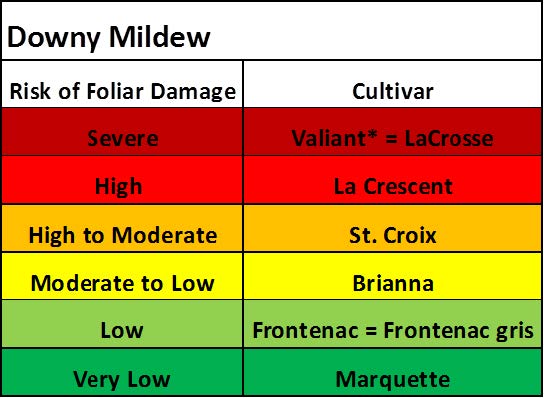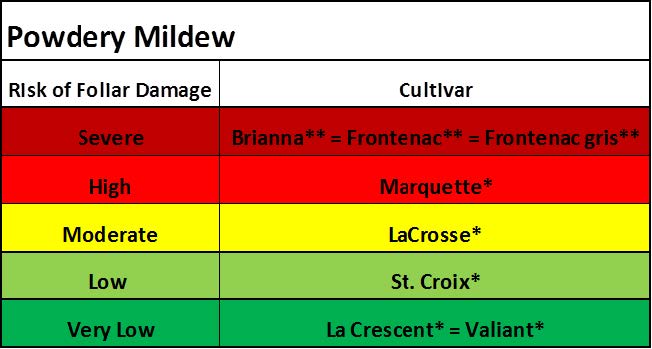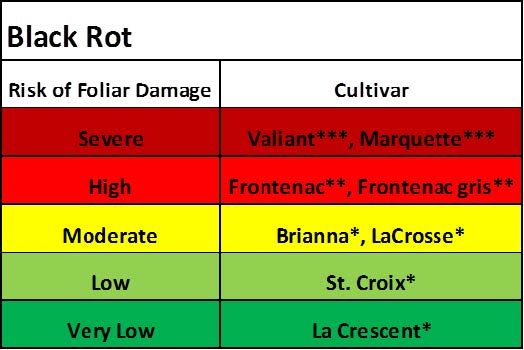Susceptibility to Downy Mildew, Powdery Mildew, and Black Rot: New Management Applications for Cold-climate Wine Grape Growers
In field trials conducted in Wisconsin over two years at three vineyards (WMARS, PARS 1, and PARS 2), we found that both severe susceptibility and relative resistance to powdery mildew, downy mildew, and black rot are present in several popular cold-climate cultivars, and that several disease susceptibility ratings published in extension literature need to be updated. Additionally, we found that for most cultivars a difference between foliar and fruit susceptibility to diseases, a distinction that is not usually made in extension resources, and that may have management implications.
Based on these data, we have created susceptibility charts displaying the relative susceptibility of both the fruit and foliage of all eight cold-climate grape cultivars included in this work. A wide spectrum of disease susceptibility is displayed within these cultivars. Future work will focus on using this information to develop spray management strategies to optimize the profitability and sustainability of grape production in the Midwest based on host plant resistance to disease. It is important to note that among the cultivars that we studied there is no “silver bullet” cultivar that provides protection from downy mildew, powdery mildew, and black rot all at once. As a result, future trials will test reduced-spray programs that focus only on those diseases that are a known threat to a specific cultivar. Such tailored spray programs should reduce costs substantially for growers compared to the “one-size-fits-all” programs currently recommended. These tables also provide valuable information for growers looking to establish new plantings, as well as for providing increased insight on the risks associated with growing each one of these eight cultivars.
Downy Mildew: While susceptibility of foliage was variable among the eight cultivars, susceptibility to the fruit was less so. Only ‘Valiant’ was susceptible to damage on fruits, suffering over 90% loss in all of our trials, while fruits on all seven other cultivars were not damaged by the disease. This suggests that downy mildew may not pose a significant threat to yield when growing cultivars with minimal foliar susceptibility to the disease; fruits are not in danger of being damaged directly by the disease, and if foliar injury is minor, then fruits would not be indirectly affected by loss of photosynthesis.
Figure 1: Relative foliar and fruit susceptibility of cold-climate cultivars to downy mildew.

*Fruits are also susceptible to downy mildew
Powdery Mildew: Unlike downy mildew, none of the eight cultivars in our trials had fruits that were fully resistant to powdery mildew. This indicates that this disease must be managed carefully, particularly on susceptible cultivars in order to avoid damage to fruits. Only La Crescent and Valiant escaped severe damage in hot, dry weather at PARS 1 in 2015, indicating that conducive weather may put nearly all of these cultivars at risk for economic damage. However, severe damage was not typical across other trials.
Figure 2: Relative susceptibility of cold-climate cultivars to powdery mildew.

**Fruits are severely susceptible to powdery mildew
*Fruits are slightly susceptible to powdery mildew
Black Rot: None of the eight cultivars were resistant to black rot damage to the fruit. However, when producing relatively less susceptible cultivars such as La Crescent and St. Croix, it might be possible to forego some early sprays but focus on sprays bloom (the peak window of susceptibility to black rot) Black rot poses proposes a minimal threat to the foliage of many cultivars, but the fruit of severely susceptible cultivars such as Marquette and highly susceptible cultivars such as Frontenac and Frontenac gris can be extensively damaged by black rot if proper management is not practiced.
Figure 3: Relative susceptibility of cold-climate cultivars to black rot.

***Fruits are severely susceptible to black rot
**Fruits are moderately susceptible to black rot
*Fruits are slightly susceptible to black rot
This article was posted in Disease, Grapes and tagged Black Rot, cold climate grapes, David S. Jones, disease, Downy mildew, Grapes, Patty McManus, Powdery mildew.
